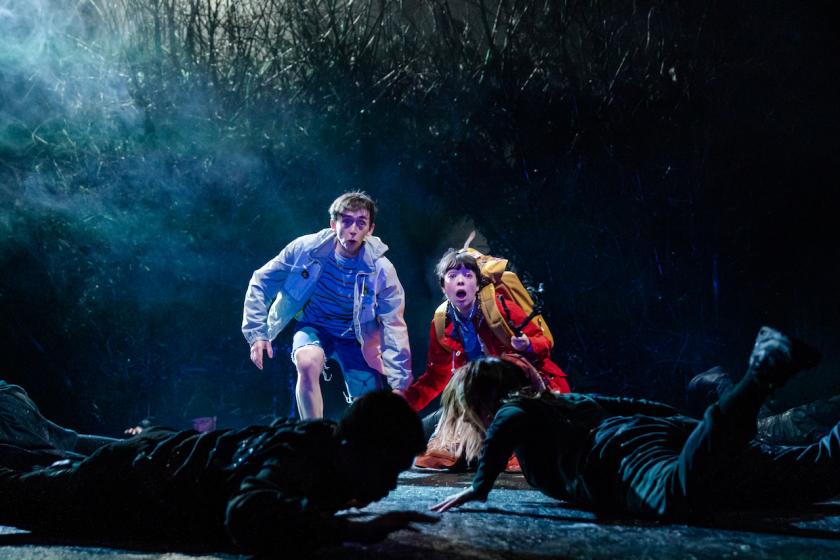This scary, electrically beautiful adaptation of Neil Gaiman’s book about living on the faultline between imagination and reality is a fantastically alternative offering for the festive season. While the parameters of the story are dark, it’s an edgy, stunningly thought through tribute to the wild and wonderful life of the mind, and its ability to help us engage with the horrors that life flings at us.
Though there is no shortage of Gothic special effects, the success of the production is due in no small part to Samuel Blenkin’s superb, comically gawky turn as the “Boy” at the centre of this coming-of-age story. In Neil Gaiman’s original book the boy is seven, but Joel Horwood’s adaptation starts the action on his twelfth birthday, when the boy and his dad discover a dead body in the family Mini.
It takes a certain kind of stage presence to be able to pull this scene off as a comedy. But Blenkin and Justin Salinger’s “Dad” don’t miss a beat in capturing the awkward absurdity of a scenario in which the dad must retrieve the boy’s birthday present – boxing gloves – from under the dead man’s body. It sets the tone for the wry humour that plays in counterpoint to a plot steeped in myth-infused horror; a pagan howl from a landscape that becomes more unpredictable the more you look at it.
Katy Rudd’s cleverly lit and soundscaped production begins at a funeral, which is evoked by dark figures with umbrellas standing around a grave opening projected as a rectangle of light onto the floor. Justin Salinger begins as a grown-up version of the boy, who, in a flash forward to the future, is attending his father’s funeral. When he wanders down the lane to the house he used to visit, he encounters Old Mrs Hempstock, one of the formidable matriarchs of the family who helped him through the darkest days of his childhood.  This production features both a ‘Magic and Illusions Director and Designer’, Jamie Harrison, and a ‘Puppetry Director’, Finn Caldwell, both of whom deploy their talents to haunting effect. The boy, who in the adaptation – unlike the book – has lost his mother a year beforehand, first becomes swept up in more mythical turn of events when he meets Marli Siu’s Lettie Hempstock. When she takes him to the nearby duckpond and describes it as an ocean it feels like a perfect metaphor for childhood imagination. The darker aspects are first hinted at when she grabs a dead fish from the water, and takes a knife to it to reveal a 50p piece inside.
This production features both a ‘Magic and Illusions Director and Designer’, Jamie Harrison, and a ‘Puppetry Director’, Finn Caldwell, both of whom deploy their talents to haunting effect. The boy, who in the adaptation – unlike the book – has lost his mother a year beforehand, first becomes swept up in more mythical turn of events when he meets Marli Siu’s Lettie Hempstock. When she takes him to the nearby duckpond and describes it as an ocean it feels like a perfect metaphor for childhood imagination. The darker aspects are first hinted at when she grabs a dead fish from the water, and takes a knife to it to reveal a 50p piece inside.
This of course is nothing compared to the entrance of Ursula Monkton (above right), Pippa Nixon’s effectively sinister “pretty-in-pink” Eighties nightmare, who transmits apple-pie homeliness even as we realise she is a manifestation of the sinister force the boy has encountered in the woods. Caldwell’s puppetry, designed by Samuel Wyer, first evokes Ursula as a vast ragged monster, a little like a cross between a spider and a ravaged marquee, who, in one of many surreal twists, finds a route into the boy through a “wormhole” in his hand.
In a motherless family, Ursula gains added potency as a potential stepmother figure when she emerges in human form. She instantly wins round the father and the boy’s sister with fake Pollyanna charm and cooked breakfasts – but Harrison’s illusions terrifyingly reveal her flipside. As the boy identifies her instantly as a monster, he realises he cannot escape her. The claustrophobia is powerfully evoked in a scene where the moment she walks out of one door on one side of the stage, she appears at another on the opposite side. Every time an escape seems to present itself, even in the boy’s head, she has found it and blocked it.
By contrast, the “white-witch” style charm of Josie Walker’s quietly charismatic Old Mrs Hempstock and Carlyss Peer’s Ginnie Hempstock helps the boy to handle the more freakish aspects of this new world by engaging with it rather than blocking it out. Emphasising that “Nothing looks like what it is on the inside” they help him to embrace the mysteries of a life in which his imagination is his best friend.
By the time of the scene in which the boy and Lettie are dragged into the ocean – stunningly animated by Caldwell – we have happily lost sight of the boundary between what’s empirically provable and what’s fantasy. It’s the mark of truly magical storytelling that charms and terrifies in equal measure, but ultimately persuades you that the greatest and most wonderful mysteries are those lurking inside your own head.















Add comment